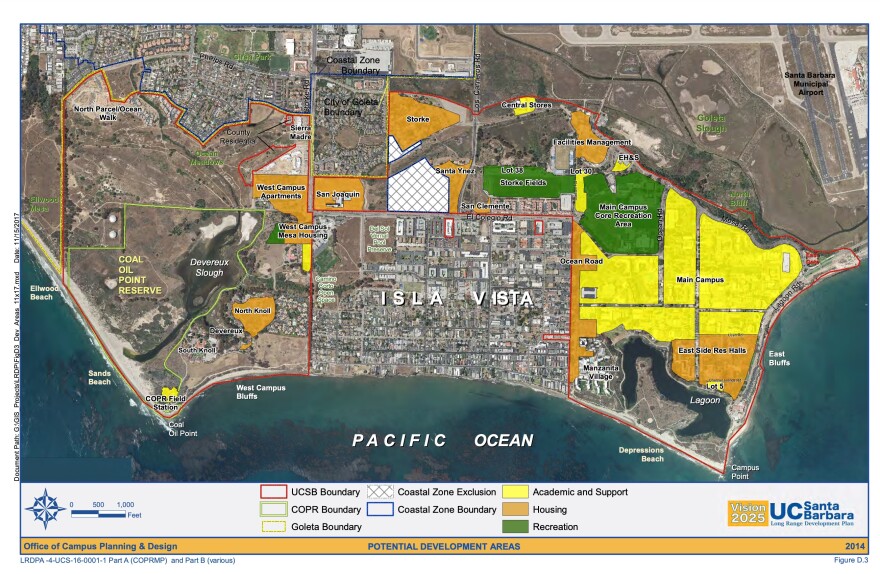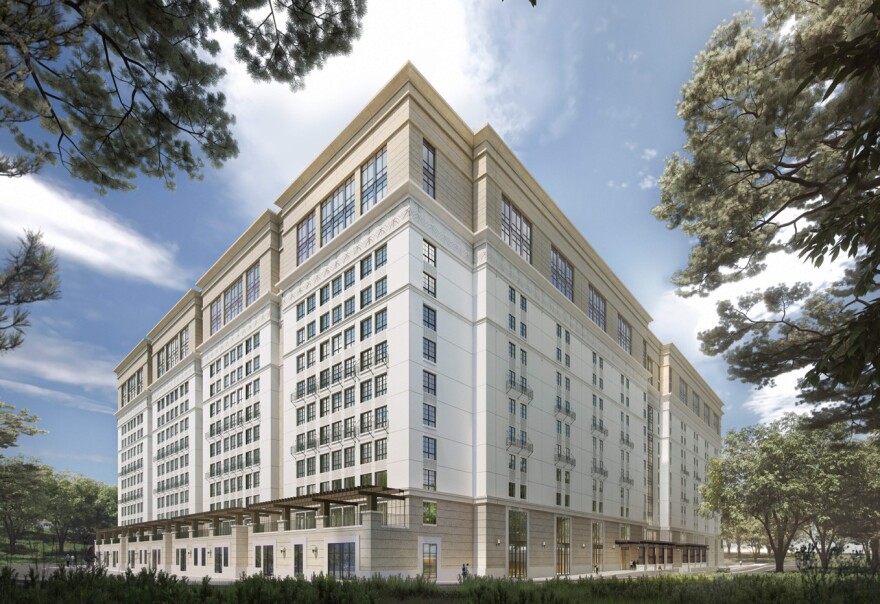The lack of housing at UC Santa Barbara affects communities far beyond the immediate campus, pushing students and faculty into Goleta or causing them to commute from even further away. Solutions exist, but the university has yet to reveal their next move.
Munger Hall, a mega-dorm proposed for student housing, is one possible but controversial solution. At this time, the general public and press do not have access to the full-scale mockup of one of the dorm‘s houses. However, KCBX did speak with a UCSB student named Max, who asked that we use only his first name.
“I knew that there were going to be real windows, and there are some real windows that are next to the common area. But in the rooms, like in your own personal room, you have an LED strip that’s above your bed, but it’s LED and there’s a curtain in front of it,” he said.
In 2015, billionaire Charles Munger gifted the campus $200 million and his own design for a building to house about 4,500 students. The project could help alleviate the campus housing crisis, but the design is controversial with its enormous size and lack of real windows.
The student housing story isn’t just about Munger Hall, though. Retired UCSB sociology professor Richard Flacks said it’s about the university’s administration setting aside all other plans when the offer from Munger came in seven years ago.
“They told us when that offer came through that this was so promising that they were not going to develop the dorms that they had originally planned for, which were more scattered, smaller-scale housing,” Flacks said.
Flacks chairs Sustainable University Now (SUN), a coalition of community watchdog groups. He said there’s a long history of community groups working together to plan for UCSB’s growth. He said the university’s 2010 Long Range Development Plan (LRDP) reached final agreement among community partners in 2014.
He said the plan was to accommodate increased enrollment from 20,000 to 25,000 by the year 2025.

“The plan that they agreed to was to house all 5,000 students — the increase of the student body — on campus. They would provide enough housing for the whole increment of the student body,” Flacks said.
But student enrollment increased more quickly than expected.
“UCSB reached the 25,000 cap in 2019, more than six years before the plan would have allowed housing to be built,” he said.
The growth was accelerated, Flacks said, by pressure from the state legislature to grow UC campuses statewide.
He said the added pressure didn’t help, but UCSB is capable of responding to the needs for housing and the existing development plan contains proposed sites and detailed design concepts. He said UCSB has plenty of open land.
“The plan identifies specific sites for all of the housing that they promised to build,” he said.
UCSB declined an interview, but the Public Affairs office sent written comments. They said they expect pre-pandemic enrollment numbers for the fall, so just under 25,000 students.
They said an environmental impact review of Munger Hall is being prepared, and the administration is gathering feedback from UCSB students and faculty invited to tour the model.
The University did build large housing complexes along Storke Road in 2014 and 2015 and combined these properties house about 1,500 students. They are also moving forward with 540 faculty and staff housing units at Ocean Road.
Flacks said the Ocean Road development is a long-awaited project that was part of the original plan, because when student enrollment goes up, the need for staff does, too.
“There’s also the fact that many faculty have been retiring and they have to be replaced, so it’s not only an increment in the size of the faculty but new faculty coming into the community looking for housing,” he said.
According to the university, their goal is to house 50% of students in their on- and off-campus properties. Their current numbers are shy of that goal, which leaves more than half of the student body to find housing in Isla Vista or surrounding communities.
Michelle Roberson, president of Sierra Property Management, said her company manages about 300 apartment units in Isla Vista.
“None of those units are available now. Everything is 100% occupied,” she said.

She said students secure their housing months ahead of time. And this year, when the application process opened in January, Roberson said students were on the ball.
“We had over 1,000 applicants for the units we had available, so that was very unique to us,” she said.
Roberson said UCSB students also live further west, in Goleta, but most undergrads prefer to live in Isla Vista, if they can.
“They all want to live next to each other and be able to walk to each others’ places. They have their own community,” she said.
The City of Goleta prefers that students live in their own community, too. They are suing UCSB over the lack of student housing and its impact on the Goleta housing market. The city said they will not discuss the status of the lawsuit, though.
As for Max, the UCSB student, he’s made up his mind about Munger Hall.
“In my opinion, I don’t think that it should be built, but is there any other option?” he said.
It appears it’s the only option UCSB is considering currently that would have a measurable impact on student housing. And the university is under immense pressure from students, faculty and the city of Goleta to find a solution soon, as the lack of campus housing is contributing to an already impossible housing crisis in Santa Barbara County.
The university said a timeframe for building Munger Hall is not yet finalized. However, if it gets approved by the UC Regents later this year, they said construction of the project could start during the 2023 Winter Quarter.
KCBX intern Christina McDermott contributed to this report.
Out of Reach is made possible by a grant from the Sunflower Foundation.
Senior editor Marisa Waddell and editor Benjamin Purper contributed to this story.





